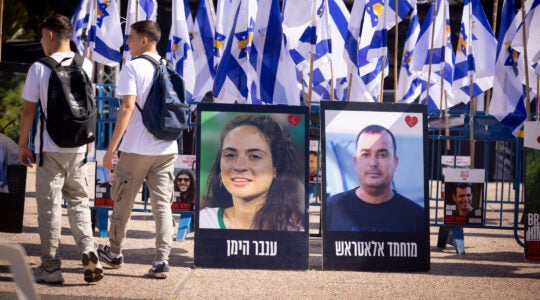SDEROT, Israel (JTA) — In the past week, Israel has endured a thousand rockets.
Yet not a single Israeli has died so far from a rocket strike during the week-long conflict.
In many ways, Israel’s Operation Protective Edge — its third Gaza operation in six years — is much like previous Israeli campaigns in the territory. Israel has used airstrikes to exact a toll on Hamas and has massed troops on the Gaza border, threatening a ground invasion.
So far, Israel has conducted nearly 1,500 airstrikes over Gaza, with some 175 Gazans having died as of Monday.
But in the absence of Israeli fatalities, this conflict has been like no other in the country’s history. Despite Hamas rockets that travel farther than ever, Israel’s Iron Dome missile defense system has intercepted 90 percent of the rockets heading toward population centers, and early-warning sirens and shelters have protected residents.
Iron Dome was first used during Israel’s 2012 conflict with Hamas, though the system has added batteries and been more fully developed since. In that conflict, six Israelis were killed, five of them from rocket fire.
Hamas’ total failure this time to kill Israelis — though several have been injured by rockets — has allowed most Israelis to continue their daily lives. And even amid discussion of a cease-fire, it has given the army breathing room to continue its mission.
“We are striking Hamas with increasing strength,” said Israeli Prime Minister Benjamin Netanyahu at a Cabinet meeting Sunday, addressing Israeli citizens. “Regarding civil defense, one needs not only an Iron Dome but iron discipline as well. You have shown this up until now. This could yet take a long time, and we need both your support and your discipline.”
Israel’s goal in this conflict is to destroy Hamas’ rocket stocks and launchers while reasserting the Israel Defense Forces’ military deterrence. Meanwhile, the Israeli home front has been guarded by Iron Dome. Within seconds of when a rocket is launched, Iron Dome identifies the type of missile fired, maps where it came from and where it will land, and — if necessary — fires a missile to knock it out of the sky.
The missile defense system has managed to intercept about 90 percent of its targets.
“If anyone hit 9 of 10 in the majors, he would be cast in gold and sent to Cooperstown,” Eran Lerman, deputy chief of Israel’s National Security Council, told a Jewish Federations of North America delegation Monday, referring to America’s Baseball Hall of Fame.
Lerman hailed Israel’s “remarkable ability to defend ourselves technologically.”
Experiencing loss of life from war has been central to the Israeli experience. Yom Hazikaron, Israel’s memorial day, is a solemn occasion for the country. Civilian and military deaths have been a key part of the calculus of when to begin and end military campaigns.
With Protective Edge, Israel has so far experienced a new kind of conflict.
But Amichai Cohen, a research fellow at the Israel Democracy Institute, wrote that Iron Dome could lead to more blame being assigned to Israel because its civilians are less exposed to harm than is Gaza’s population.
“Given the real, yet much smaller threat that rockets pose to Israeli civilian lives after the invention of Iron Dome, there is a real question of whether the IDF’s freedom of action has been curtailed,” Cohen wrote in an email sent out Monday by his institute. “Is the IDF, in effect, penalized for this life-saving technology?”
One place that doesn’t benefit from Iron Dome is Sderot, a city in the western Negev that has been absorbing Qassam rockets from Gaza since 2000. Because Sderot is only about a half-mile from the Gaza border, Iron Dome doesn’t have time to intercept the rockets. Residents have 15 seconds from the time of a warning siren to run for shelter.
Speaking to leaders of North American Jewish community federations who came to show solidarity with the city, Sderot’s mayor, Alon Davidi, encouraged the Israeli army to fight until it eliminates Hamas’ offensive capabilities. He said that the long-range rockets now being fired into the rest of the country have made millions of Israelis understand what Sderot has had to endure.
“All of the country feels what it means to want to save your life,” Davidi said. “In Tel Aviv they have two minutes. We have 15 seconds. We have a joke: If we lived in Tel Aviv we could take a shower and make coffee” before seeking shelter.
“We pray the army can do the job and succeed with the operation,” he added.
Many Israelis would likely welcome the respite from running to bomb shelters that a cease-fire would provide. But Talia Levanon, head of the Israel Trauma Coalition, said that if this operation ends like Israel’s last in 2012, there will hardly be a break in the conflict for Sderot.
Whether “it’s called an operation or it’s called a war, we need to seek shelter with my children and grandchildren, “ Levanon said. “Right now we speak of a cease-fire. We’ll wait a year or two years for it to happen again. We’re always licking the wounds of the previous operation and preparing for next time.”
JTA has documented Jewish history in real-time for over a century. Keep our journalism strong by joining us in supporting independent, award-winning reporting.






